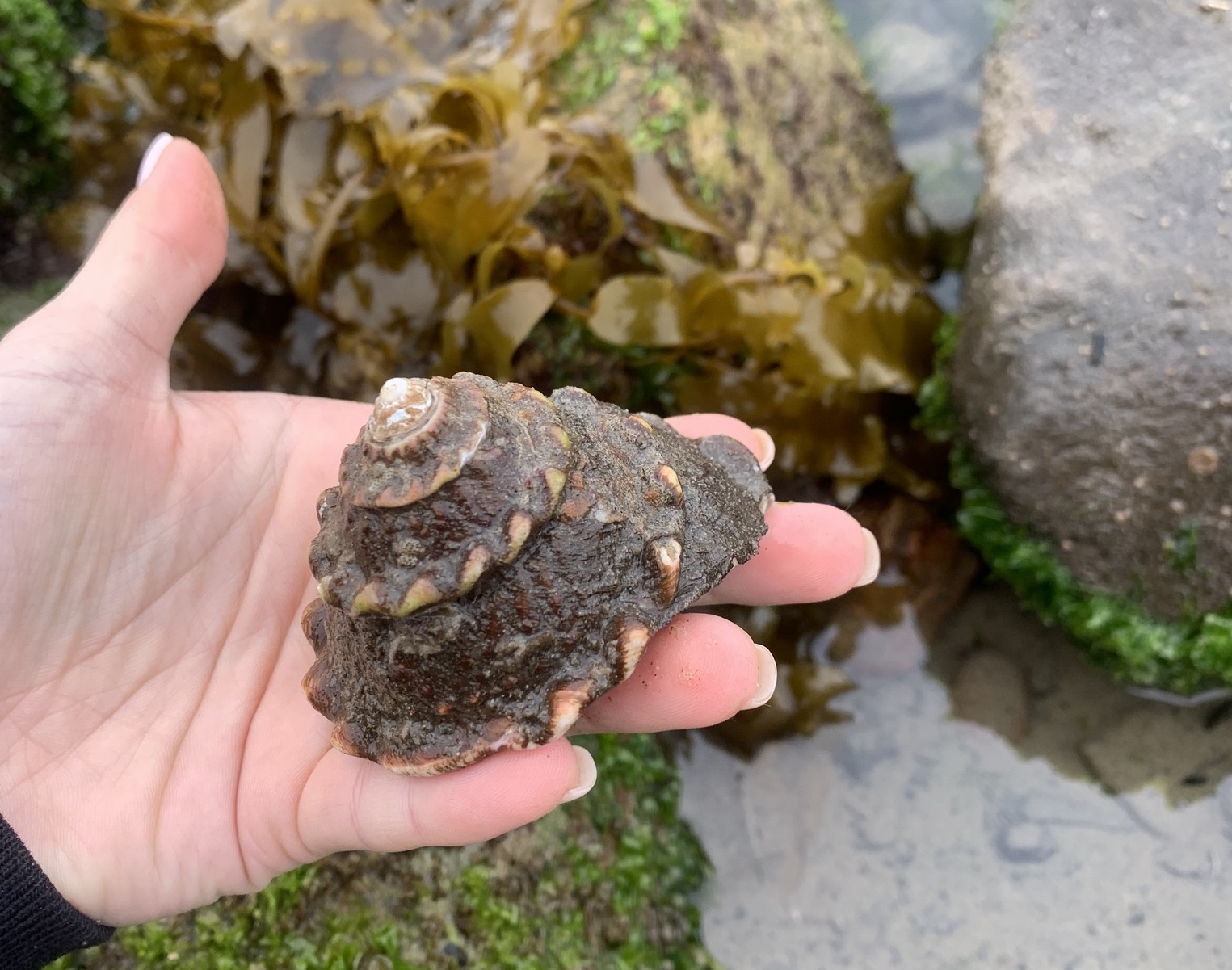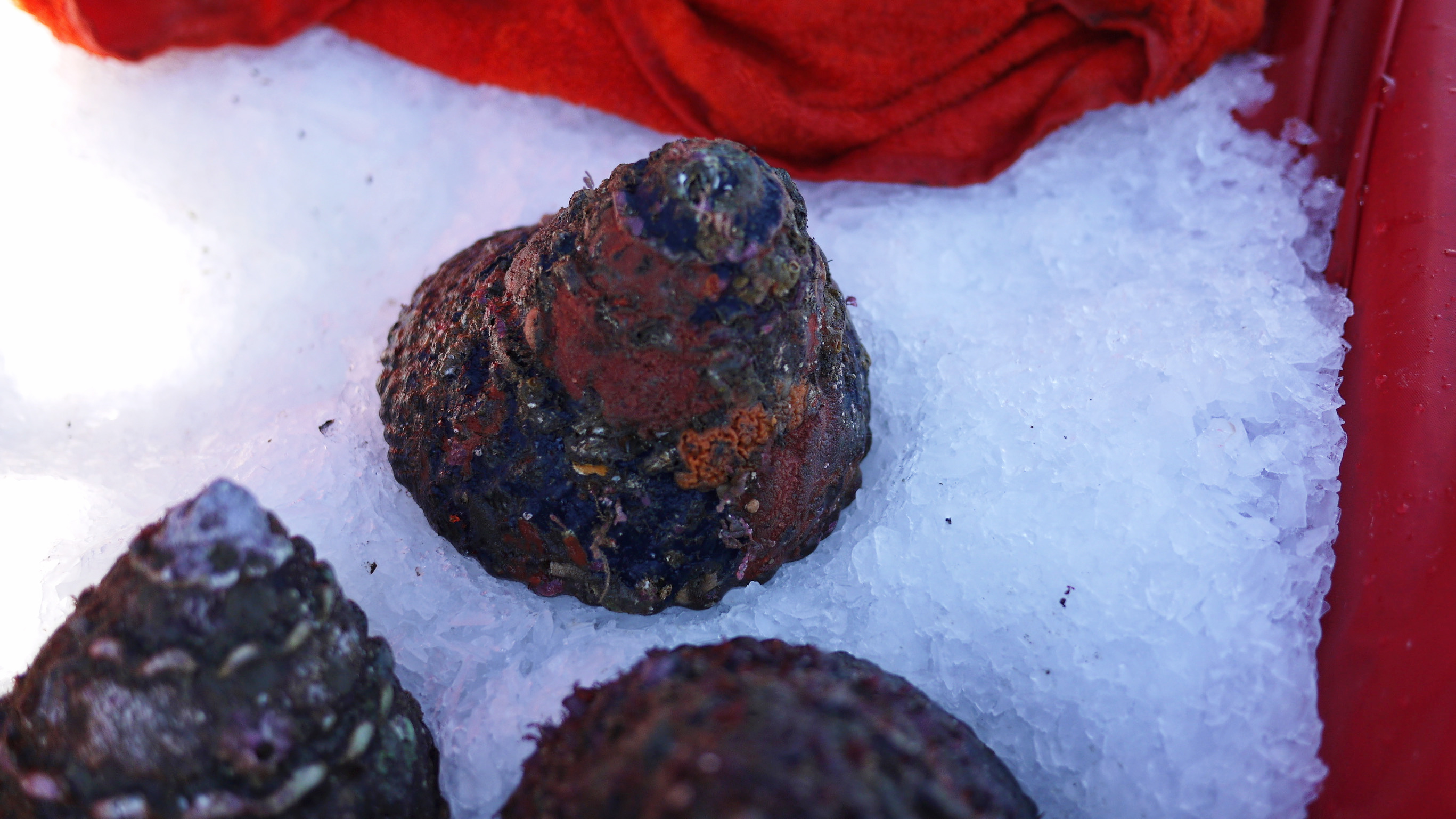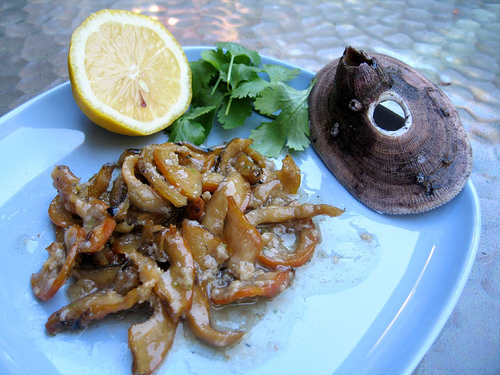Megastaea undosa
Central Coast (South of Half Moon Bay to Point Conception)
Santa Barbara (Point Conception to Point Dume)
South Coast (Point Dume to Mexico border)
Shellfish
Wild caught

The Science

Taxonomic description
- As one of the largest turbinid gastropods in California, this snail can grow its shell up to 15.24 cm (6 inches) long! [1]
- Shell is heavy with undulating ridges, and is conical in shape, with a flat base. Its color ranges from light brown to tan, and is often covered with coralline algae and other small organisms. [1]
- The operculum, or 'trap door' on the snail is hard, thick, oval, and flat with well-defined rough ridges. [1]
Distribution
- Found in California, as far south as Baja California and as far north as San Luis Obispo County. [1,2]
Life history
- Typically, smaller snails grow quickly, while growth slows for larger snails. There are two main growth periods, a low growth period in the spring and summer and a high growth period in fall and witner. [1]
- Sexually mature individuals are typically over 7.62 cm (3 inches) in shell diameter. Mature females are longer than 8.89 cm (3.5 inches) and males are longer than 7.87 cm (3.1 inches) in diameter. [1]
- Reproduction occurs year-round, but peaks in the spring and fall. [1]
Habitat
- Can be found on rocky substrate from the intertidal zone to as far deep as 76.2 m (250 ft). Smaller snails are generally in shallower waters, and larger snails are found in deeper waters. [1]
- It is an herbivorous generalist and feeds on kelp and coralline algae. Predators include sea stars, Kellet's whelks, octopuses, lobsters, and fishes. [1]
- To escape predation in kelp forests, this snail migrates up to the canopy of giant kelp at night. [1]
The Fishery

Seasonal availability
- Available year-round. [12]
Regulatory and managing authority
- As established by the Marine Life Management Act, the California Fish and Game Commission regulates the fishery, and the California Department of Fish and Wildlife manages this fishery in state waters through the CDFW’s Invertebrate Management Project. [3]
Gear type
- Typically harvested by divers. [1]
- Divers use handheld tools and net bags to collect the snails, gear which is identical to that used to collect red sea urchins. [1,5]
- Snails are hand-picked by divers, resulting in very little (or no) bycatch. [4]
- Divers make little contact with the seafloor. [1,5]
Status of the fishery
- Recorded landings began in 1992, with overseas markets for the meat and the shell. [1]
- Landings peaked in 1993, but crashed in 1994 after market demand plummeted; landings continued to fluctuate from 1995-97, and peaked again in 1998. [1]
- Fishery centered in San Diego, with most landings coming from Point Loma. [1]
Potential ecosystem impacts
- Wavy turban snails are abundantly available and have a high productivity rate, so over-harvesting is less likely. [4]
- El Niño-Southern Oscillation (ENSO) events seem to trigger recruitment, and increase mortality of larger individual turban snails; this suggests that knowledge of ENSO will be helpful in setting harvest quotas in the future. [6]
- Impacts of harvesting wavy turban snails may cascade upward to their predators, like the giant-spined sea star (P. gigantus). [6]
The Seafood

Edible portions
- Current market demand is for the foot. [1]
- The operculum should be removed. [8]
- The snail’s intestines are bitter in taste and are sometimes eaten, sometimes removed. [8,9]
Description of meat
- Has an abalone-like texture and taste; the foot of the snail is processed and sold to restaurants as an abalone-like product, “wavalone”. [1]
Culinary uses
- Most recipes for abalone and sea snails can be adapted to the wavy turban snail! [1]
- Can be prepared many ways: grilled, sautéed, battered and fried, in pastas, in chowders and soups, and in stir-fries. [8,9,10]
- For a spicy Korean sea snail salad recipe that wavy turban snail can be substitued in, visit Beyond Kimchee. [13]
- For a Bahamian conch fritter recipe that can use sea snail as a substitute, visit Nassau Paradise Island. [14]
Nutritional information
- Information is provided for 100g of raw turban snail. [7.11]
Toxicity report
- There are no known contaminants.
Seasonal availability
- Available year-round in San Diego. [1]
References
[1] Taniguchi, Ian, and Laura Rogers-Bennet, California Department of Fish and Game. 2001. California’s Living Marine Resources: A Status Report, pgs. 140-41. Available: https://nrm.dfg.ca.gov/FileHandler.ashx?DocumentID=34371
[2] Alf, Axel. Tegulidae and Turbinidae of the northeast Pacific. 2019. Zoosymposia 13: 070-082. https://doi.org/10.11646/zoosymposia.13.1.8
[3] California Department of Fish and Wildlife. 2015. Invertebrate Management Project. Web. https://www.wildlife.ca.gov/Conservation/Marine/Invertebrates. Accessed 16 Sept 2020.
[4] Micheli, F., et al. 2014. A risk-based framework for assessing the cumulative impact of multiple fisheries. Biological Conservation 176: 224-235. https://doi.org/10.1016/j.biocon.2014.05.031
[5] Seafood Watch Consulting Researcher. 2018. Sea Urchin - California, Alaska, Oregon, Washington: Diver. Web. https://www.seafoodwatch.org/-/m/sfw/pdf/reports/u/mba_seafoodwatch_uspacificurchinreport.pdf. Accessed 16 Sept 2020.
[6] Zacharias, Mark, and David J. Kushner. 2006. “Sea temperature and wave height as predictors of population size structure and density of Megastraea (Lithopoma) undosa: Implications for fishery management.” Bulletin of Marine Science 79.1: 71-82.
[7] CalorieSlism. 2015. “Turban Shell (Sazae)”. http://slism.com/calorie/110295/#foodDataDetail
[8] Dong, Michael. “How To: Wavy Top ‘Turban’ Snails.” Spearboard.com. Available: http://www.spearboard.com/showthread.php?t=99314
[9] “Grilled Sea Snails: Sazae no Tsubuyaki.” Oh My Omiyage, blog. Available: https://ohmyomiyage.wordpress.com/2012/10/04/grilled-sea-snails-sazae-no...
[10] Monterey Abalone Company. n.d. Cook Abalone. Web. https://www.montereyabalone.com/cook-abalone. Accessed 10 August 2020.
[11] SELF nutrition data. 2013. “Mollusks, snail, raw”. Web. http://nutritiondata.self.com/facts/finfish-and-shellfish-products/7742/2
[12] California Department of Fish and Wildlife. n.d. Final California Commercial Landings. Web. https://wildlife.ca.gov/fishing/commercial/landings#260042586-2019. Accessed 16 Sept 2020.
[13] H. Beyond Kimchee. 2013. Spicy Korean Sea Snail Salad. Web. https://www.beyondkimchee.com/spicy-korean-sea-snail-salad/. Accessed 3 February 2021.
[14] Nassau Paradise Island. 2015. Recipe: Conch Fritters. Web. https://www.nassauparadiseisland.com/recipe-conch-fritters. Accessed 3 February 2021.
[15] sykospark. iNaturalist. 2018. Digital image. Web. https://www.inaturalist.org/photos/13458733. Accessed 25 February 2021.
[16] mishkon. iNaturalist. 2019. Digital image. Web. https://www.inaturalist.org/photos/44499995. Accessed 25 February 2021.
